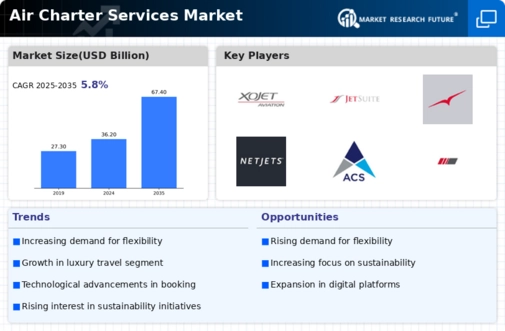Market Share
Air Charter Services Market Share Analysis
Companies use numerous techniques to position themselves, distinguish their offers, and gain market share in the highly competitive Air Charter Services industry. These market share positioning methods include service differentiation, customer-centricity, fleet diversity, technology advancements, strategic collaborations, and branding.
Charter providers differentiate their services to stand apart. Personalization, specialized experiences, and unique facilities satisfy client preferences. Customized itineraries, premium facilities, onboard dining, and concierge services attract high-end customers and increase market share.
Customer-centricity is key to Air Charter Services market share. Strong connections, client knowledge, and excellent customer service are essential. client happiness, smooth booking experiences, timely assistance, and personalised services build a loyal client base, improving market positioning and repeat business.
Charter service companies diversify their fleets to increase market share. A diversified fleet of aircraft types, sizes, and capabilities meets more client demands. Flexibility in fleets may help providers gain market share by appealing to varied business and leisure travelers.
Air Charter Services market share positioning tactics depend on technological advances. Investment in cutting-edge booking platforms, flight management systems, and user interfaces improves consumer accessibility, efficiency, and convenience. Technologies that expedite booking, allow real-time flight monitoring, and improve customer communication give providers a competitive advantage and increase market share.
Strategic partnerships and collaborations boost Air Charter Services market share. Charter firms may reach new customers by partnering with aircraft, luxury hotel, travel, and concierge services. Partnerships provide synergies, new markets, and packaged services, improving market positioning and share.
Branding and marketing are key to Air Charter Services market share. Strong brand identities, successful marketing strategies, and targeted advertising help suppliers stand out. Marketing distinctive service offerings, safety records, client testimonials, and industry honors increases market exposure and market share.
Air Charter Services market share positioning tactics still face hurdles. Providers struggle to differentiate while being cost-effective. Strategic planning and resource allocation are needed to meet regulatory requirements, safety standards, operating expenses, and competitive pricing. Service providers must also adjust to economic shifts, customer preferences, and industry dynamics.
Air Charter Services market share positioning methods include service differentiation, customer-centricity, fleet diversity, technical advances, strategic collaborations, and branding. Charter service providers must adapt these methods to changing client demands, industry trends, and regulatory requirements to stand out in the competitive aviation market.









Leave a Comment